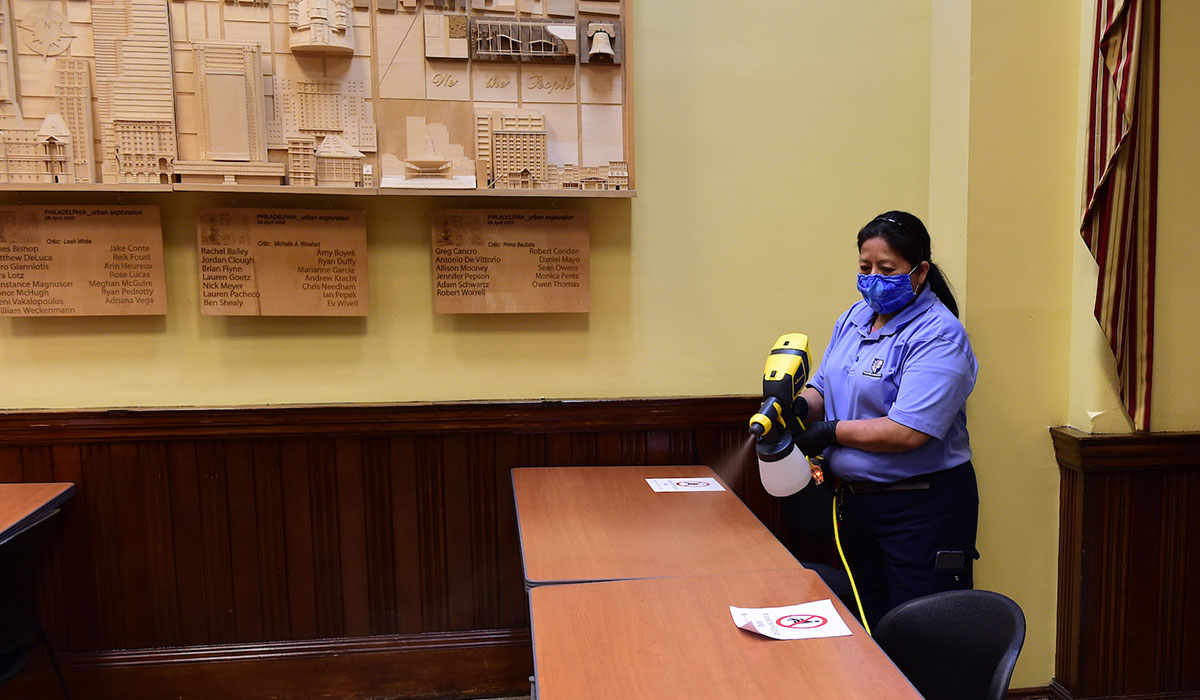

Starting last summer, facilities staff have been streamlining cleaning processes to ensure they can clean classrooms between in-person classes while also maintaining cleanliness in residence halls and other areas on campus.
University custodial staff are supported by contracted cleaners working the overnight shift. The contracted cleaners perform the traditional vacuuming, dusting, and floor cleaning of classrooms, offices, restrooms, and lounge areas in addition to disinfection overnight. During the day, custodial staff perform the traditional cleaning tasks as well as increased touchpoint cleaning in common areas in all working and living spaces on campus. Additionally, classrooms will be sanitized between classes.
Sanitizing residential and classroom spaces to the degree the University aims to meet has required collaborative engineering and creative solutions. An established University vendor created a new spray nozzle designed to transform off-the-shelf sprayers used for paint into mist cleaners. With this device, staff are able to quickly move from room to room and apply a light mist of disinfectant. The EPA-registered disinfectant — vital oxide — leaves little to no residual odor and can clean a room the size of Gowan Auditorium (up to approximately 2,700 square feet) in approximately three minutes.
For areas that are unable to be cleaned in the way a classroom is, the University has procured portable germicidal ultraviolet (GUV) units that emit UVC light energy from 200 to 280 nanometers (nm) — the established threshold for disinfection.
“These units can supplement and improve the cleaning efficiency of select targeted spaces with high occupancy loads and/or other factors such as high-touch surfaces which may otherwise be difficult to clean using more traditional methods,” says Louis Alar, senior director of environmental health, safety, and risk management. “The use of these products eliminates the need to continually restock cleaning supplies and products” for heavily used areas that require frequent cleaning.
Such spaces may include athletics facilities, Student Health Services exam rooms, music and drama performance spaces, and nursing labs.
The University is closely monitoring the evolving guidance of the D.C. Department of Health, the Centers for Disease Control (CDC), the Environmental Protection Agency (EPA), and industry and professional organizations such as the American Society of Heating, Refrigeration, and Air Conditioning Engineers (ASHRAE).
Experts agree that COVID-19 spreads mainly through close contact from person-to-person. Therefore, face coverings, physical and social distancing, hygiene, and surface cleaning are the most effective tools for risk mitigation. The University’s Return to Campus Plan includes all of these actions to reduce the risk of virus transmission.
There are some areas where experts’ statements differ and recommendations on air quality seemingly conflict. Some guidance is aimed at potentially reducing risk from the possibility that spread may also occur via airborne particles in indoor environments. For this reason, the Facilities team is actively evaluating indoor air quality conditions of all campus buildings with the support of consulting architects and engineers. As a result of this study, air ventilation and filtration improvements are complete in numerous locations across campus. The changes include the installation of mounted air handling equipment and portable air filtration units.
Increasing ventilation with outdoor air and improving air filtration are among these recommendations. However, these methods must be carefully balanced so that implementing one improvement does not counteract with another; for example, upgrading to a filter grade that a particular system cannot accommodate could interfere with the system’s overall ventilation capacity.
The guidance also recognizes that increasing ventilation with outside air may not always be possible or feasible; however, the effective rate of ventilation can be increased by limiting occupancy of indoor spaces.
“Since the HVAC systems in our spaces vary in age and design, potential improvements to these are considered part of a larger strategy that includes the fundamentals of social distancing to reduce the occupancy load, wearing face coverings, increased surface cleaning, and frequent hand washing,” says University Architect Debra Nauta-Rodriguez.
Every classroom on campus was studied this summer to determine how to rearrange seating in order to provide for the implementation of social distancing. In rooms with fixed seating, signs have been placed on seats that should not be used in order to provide at least 6 feet of space between students.
There is now at least 10 feet of space from the front of the room to the first row of student seating for instructors to utilize for teaching. Should faculty want to teach behind a physical barrier, the University is currently procuring portable plexiglass barriers.
As a result of the D.C. Mayor’s mask mandate, no student should arrive to a class without a mask. However, if they do, there will be masks available in each building for faculty to have on hand to offer to students.